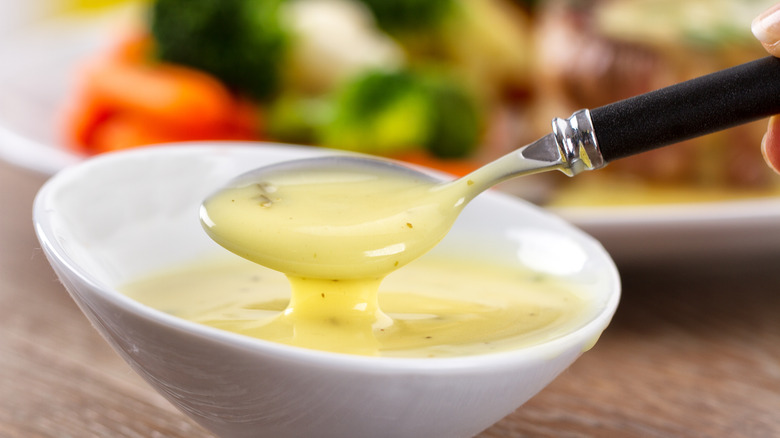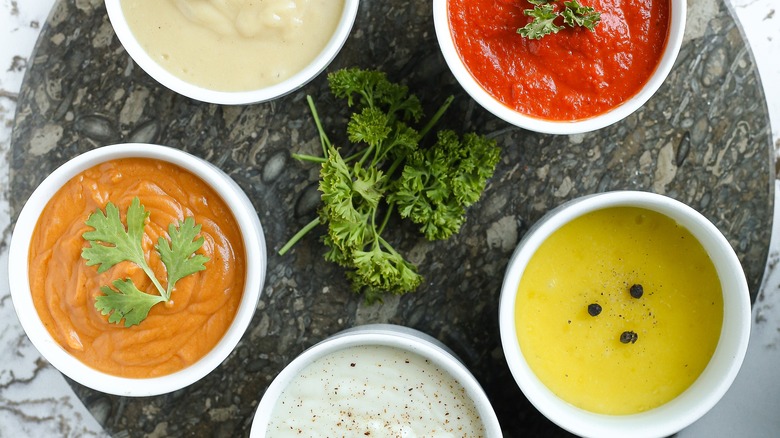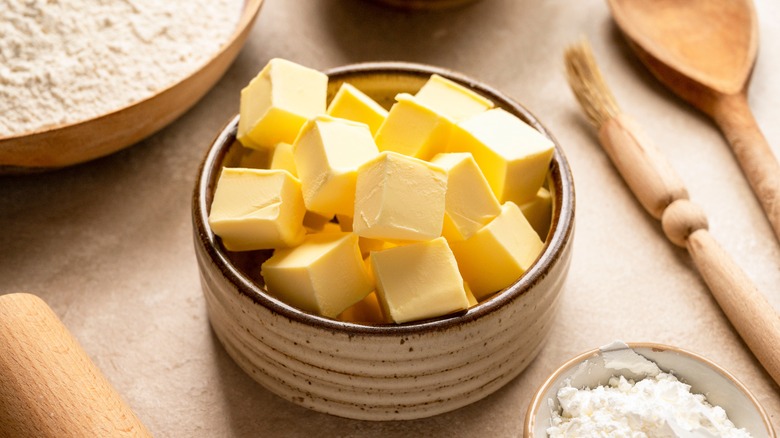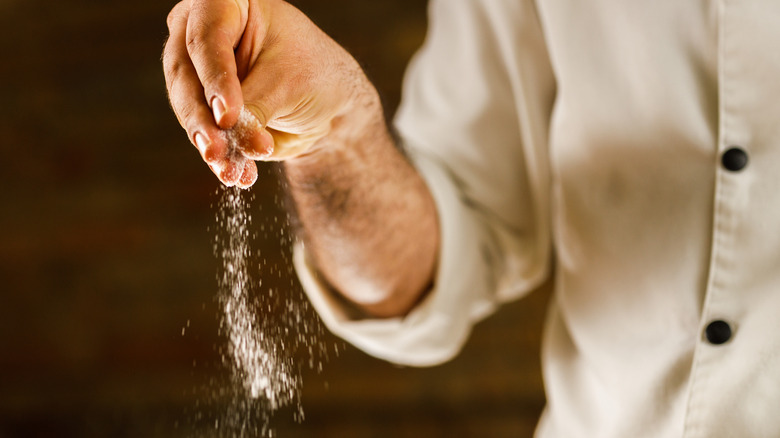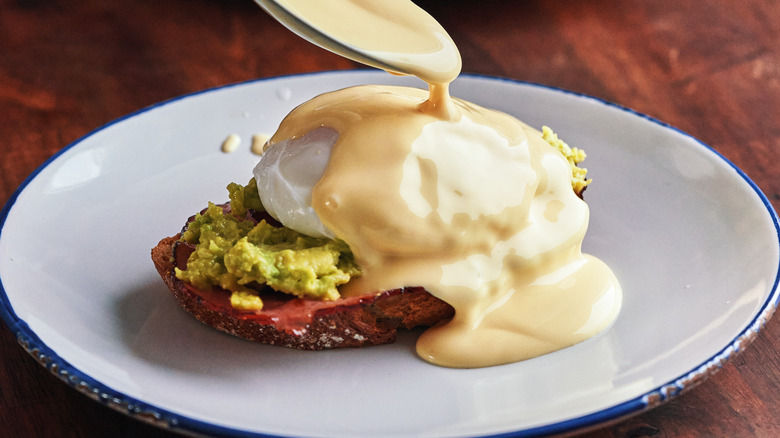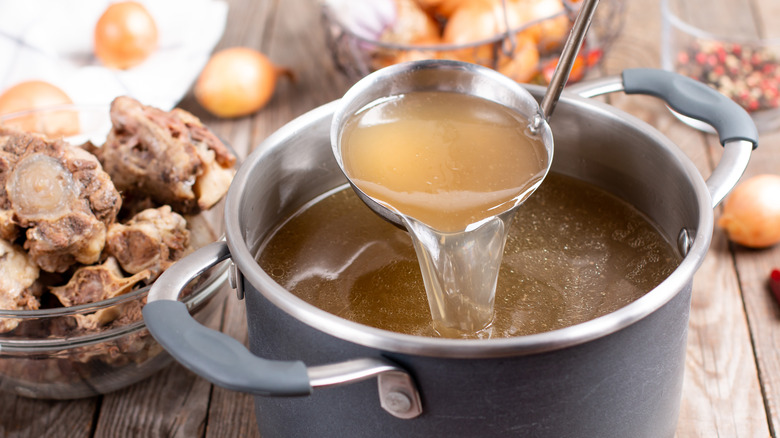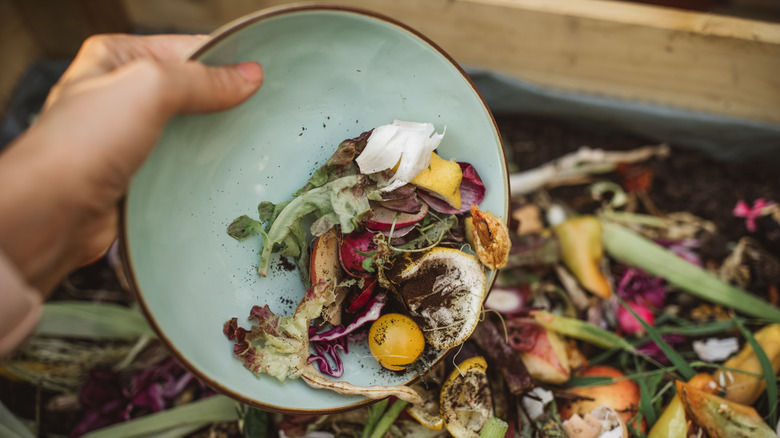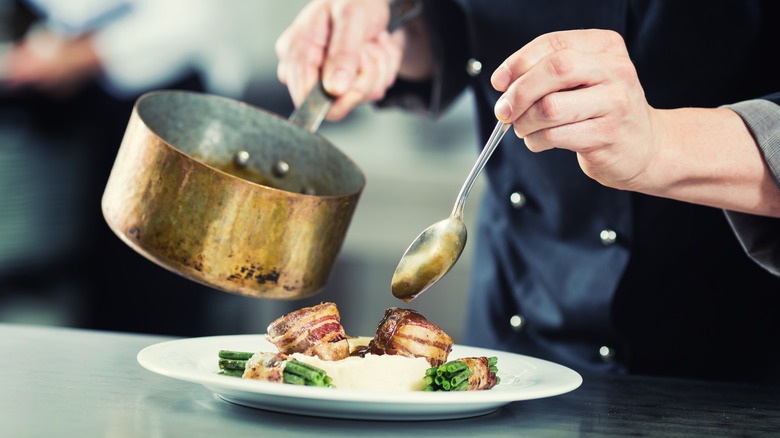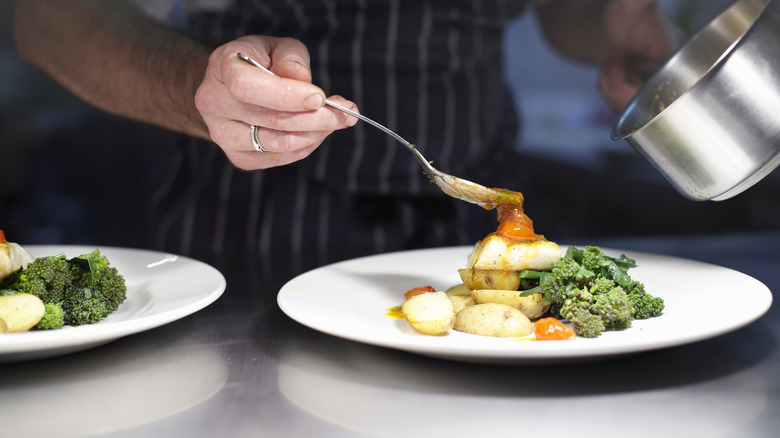Why Sauces Always Taste Better At A Restaurant, According To Chefs
Whether it's a classic French béarnaise or a house-made chili paste, the perfect sauce can often be what adds just the right allure to a dish. And while sauces are time-tested, pervasive favorites, we may be seeing more and more of them these days, according to Maxime Bouttier, chef-owner of Paris' Géosmine, due to rising trends in highlighting an ingredient in all its simplicity. In this case, he says, "What brings the products together is the sauce."
But it's not uncommon to find that despite attempting to make such sauces at home, they taste better at a restaurant. And this doesn't have to be the case! For Benjamin Ferra y Castell, head chef of Pavyllon London, which recently earned its first Michelin star, it's largely a question of exposing yourself to the right techniques, for example via online tutorials. Allison Zinder, gastronomy educator and founder of Food & Culture of France immersive trips, notes that a hands-on class could be even more useful, "preferably one that is over a few sessions so you can practice sauces in between," she says. You could also rely on cookbooks — she recommends "The Saucier's Apprentice" by Raymond Sokolov, Shirley Corriher's "Cookwise", or Julia Child's classic "Mastering the Art of French Cooking".
"If after all that you are still unsuccessful," says Zinder, "take up knitting instead of cooking." Jokes aside, our experts were happy to offer their sauciest secrets to help home cooks master the art of the sauce.
Restaurant chefs have mastered the French mother sauces
It's no accident that in France, the saucier or sauce-maker has long been seen as one of the highest-ranking members of the kitchen team, also known as the brigade. This almost military structure, now familiar to fans of The Bear, was originally the brainchild of 19th-century French Chef Georges Auguste Escoffier, who also developed the notion of the five French mother sauces: béchamel, velouté, espagnole, hollandaise, and tomato.
Mastering these five sauces is a must, according to Allison Zinder. "Literally the first sauces or really anything a culinary student in France learns to make are béchamel and velouté," she says. The reason why is evident for anyone who thinks a bit about their nickname: These sauces are "mothers" of multiple variants — about 60, according to Zinder. A béchamel into which one has melted a hefty helping of grated cheese becomes a mornay; a velouté sauce can be seasoned with mushrooms, cream, and white wine to become a sauce normande. And that's just the beginning. From a hollandaise, for example, it's just a stone's throw to an herbaceous béarnaise, and then to a choron, which sees the former jazzed up with tomato. Benjamin Ferra y Castell recommends having fun discovering new flavors once you've mastered these bases to see what other sauces you can come up with.
Restaurant chefs know how to balance flavors
Humans have the ability to taste somewhere between four and six basic tastes, depending on who you ask. To the quartet of sweet, salty, sour, and bitter, umami — savoriness — was generally embraced beginning in the 1980s, and more recently, scientists zeroed in on ammonium chloride, the metallic flavor found in salt licorice. Ayurveda, meanwhile, distinguishes the six basic tastes as sweet, sour, salty, bitter, pungent, and astringent. The key to a good sauce is allowing these flavors to coexist in harmony,
"A good sauce should be balanced, no matter what kind of sauce it is," says Allison Zinder. "But some are more desirable when they're acidic, like sauces for fish, and some are built to be sweeter, like a gastrique for duck à l'orange."
It also bears mentioning that an imbalance in some flavors is easier to correct than others. While an overly salty sauce can be balanced with the addition of acidity, sweetness, or fat, an overly acidic sauce, Zinder says, is tougher. "If a sauce is too acidic, you can always add cream or butter, but that's not always possible, with tomato sauce for example," she says, noting she often adds a carrot and onions to counterbalance the acidity. "Tomato sauce is a real balancing act and a good test of a chef's skills and palate."
Restaurant chefs aren't afraid of fat
Fat is flavor — and restaurant chefs often use far more than you'd think. "When a French recipe indicates une noix de beurre it usually means (for non-professionals) about a tablespoon of butter," says Allison Zinder. "But in professional kitchens? About twice that amount."
Even at home, she says, her pan sauces are almost always finished by being mounted by tiny cubes of very cold butter to give them a lovely richness. "Mounting a sauce with butter give you a lot of bang for your buck precisely because the butter is emulsified in the sauce."
But fat isn't just a question of quantity, according to Benjamin Ferra y Castel, who notes that good-quality butter will always render a better sauce. And just as important as the quality of the fat is when you add it. Maxime Bouttier notes that it's best to keep sauces as lean as possible while you're making them, skimming the fat from the surface of a stock, for example, to remove any impurities in the base product. This, he says, is easily done by chilling it overnight to solidify the fat into a layer that can easily be removed. The sauce can then be finished with fat, as Zinder does, to add that final luxurious richness. And Chef Jason Gouzy of Michelin-starred Pantagruel in Paris notes that in some cases, too much fat can actually make dishes fall flat, with a condensed, rich jus being the more apt choice.
Restaurant chefs season generously but prudently
Much has been made of chefs' tendency to use not just more fat, but more salt than most home cooks. In his book "Cooked," Michael Pollan shared that pro chefs told him to use three or even five times as much as he thought he needed when preparing a piece of meat to be grilled. Shocking? Sure. But this also isn't the whole truth, especially when it comes to sauces, according to Maxime Bouttier.
"Sauces generally need to be reduced," he explains. "So you won't need to add any salt." Indeed, salting an already seasoned sauce before reducing it could lead the final sauce to be way too salty, even for a chef. And salt isn't the only thing that home cooks can gauge incorrectly. The balance of acidity is essential, but adding acid to a cream-based sauce may cause it to split, which is why many cream-based sauces call for adding acids early, to warm them through before adding the cream, or slowly, so the sauce doesn't curdle.
Restaurant chefs know the science behind emulsification
From simple homemade vinaigrette to a more complex hollandaise, many sauces get their lovely texture through emulsification, a process whereby fat and water — frequent foes — are forced to combine by suspending small droplets of the former in the latter, often relying on ingredients like eggs and mustard as stabilizers. While occasionally finicky, according to Benjamin Ferra y Castel, the process "isn't difficult to master, if you theoretically understand emulsions."
Maxime Bouttier agrees. "In culinary school, we study the molecular molar mass to understand these phenomena and master sauce making," he says. Of course, understanding the theory is just part of the problem, according to Jason Gouzy, who notes that sabayons, which are hot emulsifications with an egg yolk base, require precision and mastery of the heat source to get just right.
"They're definitely fussier and more difficult to make than the others," says Allison Zinder of emulsion-based sauces. "You must develop both muscle memory and intuition, and those can only come from making these sauces over and over and over again, until you're blue in the face and no one in your household wants to eat homemade mayonnaise or hollandaise anymore! You may even risk being ostracized by friends. Or you just go work in a professional kitchen for a year or two." That said, she notes that these sauces may well be the most useful to master, perfect for crafting your own egg mayo or the perfect steak sauce.
Restaurant chefs know that often, a good sauce takes time
Some sauces, Jason Gouzy explains, are quick to make: What's easier than a vinaigrette stirred together at the very last minute? But other sauces require a bit more time, such as stocks, which Maxime Bouttier says are often the "skeleton" of a sauce. Less technical perhaps than emulsions, stocks are difficult for home cooks to get a handle on due to the sheer time they require.
"The quality of a sauce really comes down to the time and care you bring to it," Bouttier says, noting that veal stock may need to be cooked for six hours or more to bring out its fullest flavor. But there are a few tips home cooks can use to make this process easier. Gouzy suggests roasting any poultry carcasses to add even more flavor and relying on a pressure cooker to make stocks more quickly. And Allison Zinder notes that not all stocks require the same low-and-slow cooking time. Fish stock, she says, is quick by definition; cooking it any longer than 20 to 30 minutes, she says, will turn it bitter. Veggie stock, too, comes together in nearly no time. "After about an hour, the vegetables have given up all their flavor so more cooking is overkill." And the investment will surely pay off. Once you've made a big batch of stock, she recommends reducing it and freezing it in ice cube trays, so you always have some when you need it.
Restaurant chefs take advantage of what they have
Sauces don't always require a trip to the grocery store. On the contrary, many great sauces and stocks take full advantage of what's on hand, be it chicken bones or veggie trimmings. You can take advantage of this chef trick at home by keeping your trimmings carrot peelings, leek greens, and more in a freezer bag. When you have enough, buy some chicken wings to make a rich, flavorful stock.
This waste-not-want-not mindset, Maxime Bouttier says, is at the core of his entire mentality at Géosmine. "We don't buy anything just for sauces," he says, noting he takes advantage of not just veggie scraps but offal and fish heads to make his sauces, which thus vary day by day.
And potential food waste isn't the only way sauces can change depending on what you've got to hand, according to Allison Zinder. "In the fall, I was down in Gascony and picked up a particularly good bottle of Armagnac," she says, "so my sauces for the last three or four months have often been made with that!" Getting creative with what's in your pantry is a great way to come up with new flavors for your homemade sauces.
Restaurant chefs know which sauces are highly technical
While in a professional kitchen, anything's game, for our pros, some truly delicious sauces are just too technical to merit making at home. "I'd say that the only mother sauce and its derivatives that a home chef doesn't really need to master is the espagnole," says Allison Zinder. "While not especially fussy, it is long to make, and unless you just have beef and/or veal bones around the house, it does take a lot of advance preparation for not a lot of return on investment in terms of time for home cooks. Even making brown veal stock takes a long time."
To this, Jason Gouzy adds Grand Veneur sauce, a red wine-based sauce typically served with hare in the French classic lièvre à la royale. Made with a veal jus base, which demands quite a bit of time to perfect, the sauce both emulsified and enriched with cream, all of which can make it particularly finicky. While some experienced home cooks may wish to try their hands at these sauces, many would do well to leave them to the experts.
Restaurant chefs listen to their sauce
It should come as no surprise that much of the reason sauces in restaurants are so much better than the ones you make at home is that chefs have years of experience and intuition to take advantage of. To reach sauce mastery, the first step is to know which sauce to make, something that, Jason Gouzy explains, is mainly based on intuition. "The first thought you should have should be to bring out the concentrated flavors of the base element," he says. "The goal is to bring out the flavors in the dish with the sauce."
"You balance sauces by listening to the ingredient," adds Benjamin Ferra y Castell. "The dish and the sauce must complement one another." Only once you have picked a sauce will you begin to apply your technical skills. But even these take time to fully inhabit. "Knowing to skim a veal stock to remove the bitterness, planning on rest time to remove the fat clarify a sauce," Maxime Bouttier says, are skills born of experience. "Even if you're following a recipe, it's above all the quality of the cook that will determine the quality of the sauce."
Moreover, an experienced cook will know how to riff to transform a sauce into something really special. "Like in music," Allison Zinder says, "the possibilities are infinite once you know how to play the notes."
